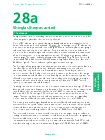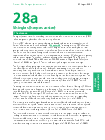Shingles (herpes zoster): the green book,book chapter 28a
Shingles immunisation information for public health professionals.
- From:
- UK Health Security Agency
- Published
- 12 July 2013
- Last updated
-
319AprilAugust20242025 — See all updates
Documents
Shingles:Shingles (herpes zoster): the green book chapter 28a (from 1 September 2023)
Ref: UKHSA publicationsgateway number GOV-151002025356
PDF, 135147 KB, 1314 pages
This file may not be suitable for users of assistive technology.
Request an accessible format.
If you use assistive technology (such as a screen reader) and need a version of this document in a more accessible format, please email publications@ukhsa.gov.uk. Please tell us what format you need. It will help us if you say what assistive technology you use.
Shingles: the green book chapter 28a (up to 31 August 2023)
Ref: PHE publications number 2021499
PDF, 150 KB, 15 pages
Details
Shingles (herpes zoster) is caused by the reactivation of a latent varicella zoster virus (VZV) infection, sometimes decades after the primary infection.
Primary VZV infection typically occurs during childhood and causes chickenpox (varicella). Following primary VZV infection, the virus enters the sensory nerves and travels along the nerve to the sensory dorsal root ganglia and establishes a permanent latent infection. It is not known what causes reactivation of the latent virus, which leads
to the clinical manifestations of shingles, but reactivation is usually associated with conditions that depress the immune system such as immunosuppressive therapy, HIV infection and/or old age.
The incidence of shingles in England and Wales is estimated to be around 790 to 880 cases per 100,000 people per year for those aged 70 to 79 years.
The risk and severity of shingles increases with age.
Changes from 1 September 20232025
Changes to the shingles programme includesinclude newthe eligibilityexpansion criteriaof for the Shingrix®eligibility vaccineto forall thoseseverely whoimmunosuppressed arepeople turningaged 6518 and 70over, afterwith 1no Septemberupper 2023.age Individualslimit. who are severely immunocompromised aged 50 years and over also become eligible.
Further information on changes to the programme are available within a letter published on GOV.UK by the UK Health Security Agency (UKHSA) and NHS England.
Updates to this page
Published 12 July 2013
Last updated 319 AprilAugust 2024
+ show2025
href="#full-history">+ show all updates
-
Sign up for emails or print this page
Update history
2025-08-19 11:03
Updated to reflect the expansion in vaccine eligibility to severely immunosuppressed adults aged 18 years and over. The text has been revised to clarify co-administration and reinforce immunisation.
2024-04-03 10:56
Updated ‘Shingles: the green book chapter 28a (from 1 September 2023)’ to clarify dosage and schedule information.
2023-07-26 17:09
Added the correct interval for people receiving the vaccine in Northern Ireland.
2023-07-17 17:39
Added chapter to be used from 1 September 2023.
Shingles:Shingles (herpes zoster): the green book chapter 28a (from 1 September 2023)
Ref: UKHSA publicationsgateway number GOV-151002025356
PDF, 135147 KB, 1314 pages
This file may not be suitable for users of assistive technology.
Request an accessible format.
If you use assistive technology (such as a screen reader) and need a version of this document in a more accessible format, please email publications@ukhsa.gov.uk. Please tell us what format you need. It will help us if you say what assistive technology you use.
Shingles: the green book chapter 28a (up to 31 August 2023)
Ref: PHE publications number 2021499
PDF, 150 KB, 15 pages
Details
Shingles (herpes zoster) is caused by the reactivation of a latent varicella zoster virus (VZV) infection, sometimes decades after the primary infection.
Primary VZV infection typically occurs during childhood and causes chickenpox (varicella). Following primary VZV infection, the virus enters the sensory nerves and travels along the nerve to the sensory dorsal root ganglia and establishes a permanent latent infection. It is not known what causes reactivation of the latent virus, which leads
to the clinical manifestations of shingles, but reactivation is usually associated with conditions that depress the immune system such as immunosuppressive therapy, HIV infection and/or old age.
The incidence of shingles in England and Wales is estimated to be around 790 to 880 cases per 100,000 people per year for those aged 70 to 79 years.
The risk and severity of shingles increases with age.
Changes from 1 September 20232025
Changes to the shingles programme includesinclude newthe eligibilityexpansion criteriaof for the Shingrix®eligibility vaccineto forall thoseseverely whoimmunosuppressed arepeople turningaged 6518 and 70over, afterwith 1no Septemberupper 2023.age Individualslimit. who are severely immunocompromised aged 50 years and over also become eligible.
Further information on changes to the programme are available within a letter published on GOV.UK by the UK Health Security Agency (UKHSA) and NHS England.
Updates to this page
Published 12 July 2013
Last updated 319 AprilAugust 2024
+ show2025
href="#full-history">+ show all updates
-
Sign up for emails or print this page
Update history
2025-08-19 11:03
Updated to reflect the expansion in vaccine eligibility to severely immunosuppressed adults aged 18 years and over. The text has been revised to clarify co-administration and reinforce immunisation.
2024-04-03 10:56
Updated ‘Shingles: the green book chapter 28a (from 1 September 2023)’ to clarify dosage and schedule information.
2023-07-26 17:09
Added the correct interval for people receiving the vaccine in Northern Ireland.
2023-07-17 17:39
Added chapter to be used from 1 September 2023.
Details
Shingles (herpes zoster) is caused by the reactivation of a latent varicella zoster virus (VZV) infection, sometimes decades after the primary infection.
Primary VZV infection typically occurs during childhood and causes chickenpox (varicella). Following primary VZV infection, the virus enters the sensory nerves and travels along the nerve to the sensory dorsal root ganglia and establishes a permanent latent infection. It is not known what causes reactivation of the latent virus, which leads to the clinical manifestations of shingles, but reactivation is usually associated with conditions that depress the immune system such as immunosuppressive therapy, HIV infection and/or old age.
The incidence of shingles in England and Wales is estimated to be around 790 to 880 cases per 100,000 people per year for those aged 70 to 79 years.
The risk and severity of shingles increases with age.
Changes from 1 September 20232025
Changes to the shingles programme includesinclude newthe eligibilityexpansion criteriaof for the Shingrix®eligibility vaccineto forall thoseseverely whoimmunosuppressed arepeople turningaged 6518 and 70over, afterwith 1no Septemberupper 2023.age Individualslimit. who are severely immunocompromised aged 50 years and over also become eligible.
Further information on changes to the programme are available within a letter published on GOV.UK by the UK Health Security Agency (UKHSA) and NHS England.
Updates to this page
Sign up for emails or print this page
Update history
2025-08-19 11:03
Updated to reflect the expansion in vaccine eligibility to severely immunosuppressed adults aged 18 years and over. The text has been revised to clarify co-administration and reinforce immunisation.
2024-04-03 10:56
Updated ‘Shingles: the green book chapter 28a (from 1 September 2023)’ to clarify dosage and schedule information.
2023-07-26 17:09
Added the correct interval for people receiving the vaccine in Northern Ireland.
2023-07-17 17:39
Added chapter to be used from 1 September 2023.

